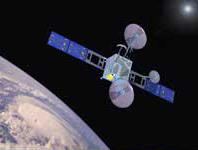Knowing how the Earth is changing is key to understanding the
consequences of those changes. In mankind's endeavor to understand
our planet's "system" and the interactions of its components (land,
sea, and atmosphere) we must strive to increase our scientific,
technological, and operational expertise.
The New Millennium Program's (NMP) Earth Observing 3 (EO3) mission, called GIFTS, is the first step
in improving our operational weather observing systems. In addition to being the mission name, "GIFTS" is also the mission instrument——the Geosynchronous Imaging Fourier Transform Spectrometer. This instrument incorporates the breakthrough technologies of an innovative atmospheric measuring concept developed at NASA's Langley Research Center in Hampton, Virginia. To accomplish the GIFTS mission NASA will partner with the US Department of Naval Research's (ONR). ONR's Indian Ocean
Meteorological Imager, called IOMI, will demonstrate GIFTS concepts and technologies.

|
GIFTS-IOMI will geosynchronously orbit the Earth from 22,000 miles high. This means that the satellite, while remaining in a fixed position relative to Earth, will fly in an equatorial orbit at the same speed and angle as the Earth's rotation. This will allow extended monitoring of large regions of our
planet and enable our ability to observe the formation of weather
patterns, at higher resolution than we currently achieve with existing
geostationary satellites.
As a "byproduct" of flight-testing new measurement concepts and advanced technologies, the mission
will also collect and return atmospheric data. This data will be
analyzed throughout the mission by the National Oceanic and Atmospheric
Administration and used by scientists to study the chemistry of
our atmosphere.
GIFTS may radically improve
our ability to observe, analyze, and predict weather, enabling
scientists and meteorologists to forecast weather with a higher
level of accuracy in the future. This is especially important in
the forecasting of severe weather, such as hurricanes and tornadoes. And, improved climate-change predictions are beneficial on other
fronts: crop forecasting, air travel, and energy usage.
About EO3-GIFTS | Mission Concept